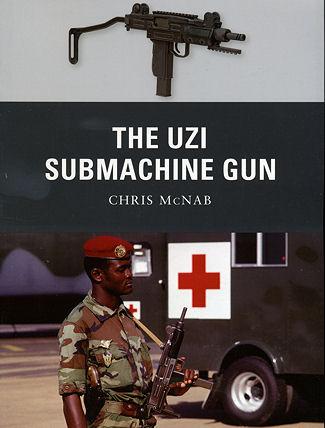 Number
12
in their 'Weapons' book series, Osprey has chosen the Uzi Submachine gun. This
is probably the most famous submachine gun known to the average person. It has
been built in fairly large numbers and had the benefit of being inexpensive to
make, easy to maintain and easy to repair, thanks to many of the components
being made of stamped steel. It is also quite easy to shoot from the hip, is
quite lethal at close range and carries a respectable sized magazine. It is used
by armies and thugs alike.
Number
12
in their 'Weapons' book series, Osprey has chosen the Uzi Submachine gun. This
is probably the most famous submachine gun known to the average person. It has
been built in fairly large numbers and had the benefit of being inexpensive to
make, easy to maintain and easy to repair, thanks to many of the components
being made of stamped steel. It is also quite easy to shoot from the hip, is
quite lethal at close range and carries a respectable sized magazine. It is used
by armies and thugs alike.
Developed by Uziel Gal, a young man who, born Gothard
Glas, emigrated from Germany to Britain and finally to Palestine in 1936. When
the state of Israel was formed in 1948, they fought with whatever had been
around so there was a bewildering number of guns and calibers used by Israeli
forces. Once the war was over, it was decided that the army needed to
standardize its weapons. They knew they would need a submachine gun so put out a
request for prototypes. Gal developed his gun that was influenced by several
design features of the Czech CZ 25. Most notably the ammunition clip in the base
of the gun's handle. Much to his embarrassment, they named the gun after him.
The original Uzi also had a wooden stock which was later replaced by a metal one
that could be easily removed and stored. The weapon went through trials with
other designs and was a clear winner. Some minor changes were required as it
seems all military weapons need to have done, but it was accepted into service
in the Israeli Army.
The thing about these types of guns is that though
having a short barrel and being pretty ineffective as a long range weapon, in
the area of up to 250-300 yards, they are quite good. Since most fighting is no
longer long range rifle exchanges, the size of the gun makes it quite easy to
handle in urban areas and in close quarters inside confined spaces, such as
rooms. They also are perfect for special ops work where compactness is almost a
requirement. They are also useful for police work for the same reason.
Unfortunately, it is this compactness that also makes them so popular with
criminals. They are able to be smuggled about and are lethal to anyone who gets
in their way.
Developed into upgraded and downsized versions, the Uzi
has pretty well been replaced in many military forces who initially used them by
the assault rifle such as the M-16 and AK-47, they are still quite useful in
covert ops and other areas where a high rate of fire from a compact SMG are
needed.
Author Chris McNab tells us the story of the
Uzi from its inception, through various modification, trials and
tribulations until it was finally replaced by the modern assault rifle. Like
all books in this series, it is accompanied by period and modern photos of the different
variations and of those who carried the gun into combat. I am pleased to notice
that not much space has been taken on 'how to fire and maintain' the rifle as I
have seen in some other books in this series, though that is certainly in this
one.
It all makes for another fine book and if you are
interested in weapons, then this book would make a fine addition to your
library.
April 2012
For more on the complete line of Osprey books,
visit www.ospreypublishing.com
or contact them at Osprey Direct, PO Box 140, Wellingborough, Northants,
NN8 2FA, UK. In the US, it is
Osprey Direct at 44-02 23rd St, Suite 219, Long Island City, NY 11101., where you can
get a catalogue of available books.
If you would like your product reviewed fairly and quickly, please
contact
me or see other details in the Note to
Contributors.
 Number
12
in their 'Weapons' book series, Osprey has chosen the Uzi Submachine gun. This
is probably the most famous submachine gun known to the average person. It has
been built in fairly large numbers and had the benefit of being inexpensive to
make, easy to maintain and easy to repair, thanks to many of the components
being made of stamped steel. It is also quite easy to shoot from the hip, is
quite lethal at close range and carries a respectable sized magazine. It is used
by armies and thugs alike.
Number
12
in their 'Weapons' book series, Osprey has chosen the Uzi Submachine gun. This
is probably the most famous submachine gun known to the average person. It has
been built in fairly large numbers and had the benefit of being inexpensive to
make, easy to maintain and easy to repair, thanks to many of the components
being made of stamped steel. It is also quite easy to shoot from the hip, is
quite lethal at close range and carries a respectable sized magazine. It is used
by armies and thugs alike.